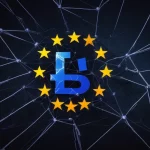Kremlin-Backed A7A5 Stablecoin Moves $6B, Dodges Sanctions on Tron and Ethereum

Kremlin-Backed A7A5 Stablecoin Moves Billions, Evading Sanctions on Tron and Ethereum
Russia has built a formidable financial workaround with A7A5, a Kremlin-backed stablecoin central to its A7 cross-border payment network, designed to sidestep Western sanctions imposed after the 2022 invasion of Ukraine. With over $6 billion flowing through this system since August, Moscow is leveraging blockchain technology on Tron and Ethereum to sustain its war economy, while employing audacious tactics to obscure ties to blacklisted entities. This isn’t just a crypto story—it’s a geopolitical chess move with far-reaching consequences.
- Massive Transactions: Over $6.1 billion moved through A7A5 since U.S. sanctions targeted related entities in August.
- Sanctions Evasion: Token destruction and re-minting hide links to blacklisted funds tied to exchanges like Grinex.
- State Involvement: Backed by Promsvyazbank and recognized as a digital financial asset, A7A5 underpins Russia’s sanctioned trade.
Origins of A7A5: Russia’s Sanctions Workaround
Following Russia’s military actions in Ukraine in 2022, Western nations unleashed a barrage of sanctions, cutting Moscow off from the global financial system. A key blow was exclusion from SWIFT, the international messaging network that facilitates bank transfers across borders. With traditional banking channels choked, Russia faced an urgent need for alternatives to keep trade alive—enter the A7 network, a state-supported payment system, and its linchpin, the A7A5 stablecoin. Officially recognized last week as a digital financial asset—a legal designation in Russia implying state oversight—A7A5 is pegged to the rouble and backed by Promsvyazbank, a state-owned defense lender holding a 49% stake in A7. This isn’t some rogue crypto project; it’s a deliberate tool for economic survival.
Petr Fradkov, CEO of Promsvyazbank, laid out the vision plainly when speaking to Vladimir Putin:
“We are creating a system of cross-border settlements based on A7.”
This statement isn’t just corporate fluff—it’s a declaration of intent. Russia is weaponizing blockchain to bypass Western financial controls, enabling exporters and importers to transact without relying on sanctioned banks. But as we dig deeper, the mechanics and motives behind A7A5 reveal a murkier picture, one that challenges the very ideals of decentralization many in the crypto space hold dear.
Technical Tricks: Burning and Re-Minting Tokens
At its core, A7A5 operates on two prominent blockchain platforms: Tron, known for its low transaction fees and rapid processing, and Ethereum, a widely adopted network with robust infrastructure. For the uninitiated, blockchains are decentralized ledgers where transactions are recorded transparently and immutably—think of them as a public record book no single entity controls. Stablecoins like A7A5 are cryptocurrencies designed to maintain a stable value, often tied to a fiat currency like the rouble, making them less volatile and ideal for payments. In theory, this setup should ensure clarity and trust. In practice, Russia’s use of A7A5 is anything but transparent.
Since the U.S. imposed sanctions on Grinex in August—an exchange linked to A7A5 and deemed a successor to the infamous Garantex, which was shut down in March for ties to hacking, ransomware, terrorism, and drug trafficking—operators have pulled a digital sleight of hand. Over 80% of A7A5’s token supply has been destroyed and re-minted in new wallets to break traceability to blacklisted funds. Think of it as shredding a stack of marked cash and printing fresh bills to pass off as clean. Commands like “destroyBlackFunds” aren’t subtle; they’re a blatant middle finger to accountability. On March 10, for example, 4.5 billion A7A5 tokens zipped between four wallets in just ten minutes, funneling money back to Grinex. A newer wallet, handling a staggering $6.1 billion since, acts as the latest hub for these shadowy flows, according to on-chain data.
Why choose Tron and Ethereum for this? Tron’s dirt-cheap fees—often fractions of a cent per transaction—make it perfect for high-volume moves without racking up costs. Ethereum, despite higher fees, offers a veneer of legitimacy with its massive user base and developer ecosystem. Together, they enable rapid, scalable operations while muddying the waters of oversight. This isn’t innovation for freedom; it’s obfuscation with a tech twist, exploiting the very systems built to empower individuals against centralized control.
State Backing and Illicit Ties
The operational DNA of A7A5 is unmistakably Russian. Transaction spikes align with Moscow’s working hours, peaking between 10 a.m. and 12 p.m., while its chatbot operates weekdays from 10 a.m. to 8 p.m. local time—hardly the footprint of a global, 24/7 network. Want to buy A7A5 with cash? Stroll up to Grinex’s over-the-counter desk on the 14th floor of Moscow’s Federation Tower, a location once tied to Garantex before its downfall. Transparency, apparently, comes with a Kremlin skyline view.
Ilan Șor, the fugitive Moldovan oligarch and majority owner of A7, has the gall to pitch this as aboveboard. Speaking to Kommersant, he claimed:
“We’ve created a transparent and honest business: we pay taxes and operate openly… [other countries are showing interest in this] alternative payment system that is beneficial for the Russian state.”
Transparent and honest? Spare me. Grinex sits on the U.S. blacklist, and Garantex’s rap sheet reads like a crime novel—hacking, ransomware, terrorism, drug trafficking. This isn’t a one-off; it’s a pattern. Recall the 2016 DNC hack or countless crypto laundering schemes tied to Russian actors. After Garantex’s closure, Tether froze $28 million in related wallets under U.S. pressure. A7A5’s current playbook—burning tokens, spinning up new wallets—seems custom-built to dodge a repeat. Yet the stink of illicit activity clings tight, no matter how many digital erasers they wield.
Global Ambitions: A Parallel Financial Network
A7 isn’t content to stay domestic. Backed by hefty loans from VEB, a Russian state development bank, the network is spreading its tentacles into Africa and piquing interest from other nations. Specific targets remain murky, but regions like West Africa, with histories of Russian economic ties, could be prime candidates. The Centre for Information Resilience, a London-based research group, sounded the alarm:
“A7 is expanding at rapid pace funded in large part by loans from Russian state institutions… [Russia’s war economy will raise the network’s] political significance in enabling exports.”
This isn’t just about moving money; it’s about building a parallel financial system to rival Western dominance. Șor boasts A7 has shifted over $86 billion in ten months—a figure that, if true, positions it as a heavyweight in sanctions evasion, as detailed in reports about Kremlin-backed crypto systems moving massive sums. For nations chafing under U.S.-led financial controls, A7A5 offers a blueprint: leverage blockchain for autonomy. But let’s not ignore the flip side. Unregulated capital flows into unstable regions could fuel conflict, corruption, or worse. This Kremlin-backed cryptocurrency isn’t just a tool for trade; it’s a potential geopolitical weapon.
The Other Side: A Lifeline for Russians?
Let’s play devil’s advocate for a moment. For ordinary Russians—small business owners, exporters, or citizens cut off from global markets—A7A5 might be a genuine lifeline. Sanctions don’t just punish oligarchs; they strangle everyday people trying to buy goods or pay suppliers. If a decentralized system, even one with state fingerprints, lets a grocer in Novosibirsk import essentials, isn’t that a win for disrupting monopolistic financial control? As a Bitcoin maximalist, I can’t help but nod at the irony: centralized Western systems pushed Russia to innovate, accelerating the very decentralization we champion.
But here’s the rub—and it’s a big one. There’s little evidence A7A5 primarily serves mom-and-pop shops. The scale of transactions, ties to disreputable exchanges, and state-driven expansion scream war economy, not grassroots relief. Freedom in crypto doesn’t mean a blank check for fraud or geopolitical gamesmanship. While I root for systems that challenge the status quo, I’m not naive enough to ignore that this particular hammer is swung by a state with a track record of wielding tech for darker ends.
Crypto’s Double-Edged Sword
A7A5 isn’t just a stablecoin; it’s a glaring case study in blockchain’s duality. On one hand, it embodies the disruptive potential we Bitcoin purists celebrate—breaking free from centralized financial chokeholds. On the other, it’s a stark reminder that technology is agnostic. Tron and Ethereum weren’t built to prop up war economies or launder blacklisted funds, yet here we are. This Kremlin-backed cryptocurrency forces us to confront an uncomfortable truth: the tools of freedom can just as easily serve the agendas of power players, saint or sinner.
From an effective accelerationism standpoint, there’s a silver lining, albeit a grim one. A7A5’s existence, flaws and all, is shoving blockchain into the geopolitical spotlight faster than any whitepaper could. Whether through innovation or regulation, the world must reckon with decentralized tech’s potential now, not later. But at what cost? For every step toward adoption, there’s a shadow of misuse. As much as I champion Bitcoin and the ethos of privacy and autonomy, I can’t turn a blind eye to how state-backed systems like A7A5 risk tainting the integrity of this space.
What about regulatory pushback? The U.S. and EU haven’t yet announced specific countermeasures targeting A7A5, but blockchain analytics firms like Chainalysis are likely hot on the trail, tracking wallet patterns despite re-minting tricks. Past freezes, like Tether’s $28 million lock on Garantex funds, prove sanctions can bite if transactions touch regulated stablecoins or exchanges. Yet, with Russia operating in “friendly” jurisdictions like Kyrgyzstan—where A7A5’s issuer, Old Vector, is registered—enforcement remains a cat-and-mouse game. The longer this drags, the more other sanctioned states might take notes, turning crypto into a backdoor for global capital flows.
Key Takeaways and Burning Questions
- What is A7A5’s role in Russia’s financial strategy?
It’s a vital mechanism for cross-border payments, enabling Russia to bypass Western sanctions and maintain trade amidst isolation following the 2022 Ukraine invasion. - How does A7A5 evade U.S. sanctions?
By destroying and re-minting tokens in fresh wallets, operators sever links to blacklisted entities like Grinex, moving billions with reduced traceability on Tron and Ethereum blockchains. - Why is the A7 network crucial to Russia’s war economy?
It supports exports and imports through a sanctions-resistant framework, amplified by backing from state entities like Promsvyazbank and VEB, bolstering its economic and political weight. - What are the global implications of A7’s expansion?
Spreading into Africa and drawing interest from other nations, A7 could forge a parallel financial network, risking unregulated money flows and deeper sanctions circumvention. - How does this showcase blockchain’s geopolitical impact?
A7A5’s operation on Tron and Ethereum highlights how blockchain can empower states to dodge financial controls, balancing autonomy with the danger of illicit exploitation. - Can Bitcoin and decentralized tech stay neutral in conflicts?
In theory, yes—tech is agnostic. In reality, state actors like Russia using blockchain for sanctions evasion show how ideals of neutrality clash with real-world misuse. - Does A7A5 accelerate blockchain adoption, for better or worse?
It forces global attention on decentralized systems, aligning with effective accelerationism, but risks tainting the space with associations to war economies and illicit funds.
Make no mistake, A7A5 is a wake-up call. As someone who lives and breathes Bitcoin’s promise of freedom, I’m torn. Russia’s blockchain gamble is a bold middle finger to sanctions, sure, but it’s also a distortion of what decentralization should stand for. When billions move under state directives, tied to questionable exchanges and geopolitical agendas, we’re not just witnessing tech innovation—we’re seeing power plays. The board is shifting, and whether it tilts toward liberation or exploitation depends on how we, as a community, navigate the fallout. One thing’s certain: the stakes for privacy, autonomy, and blockchain’s soul have never been higher.



